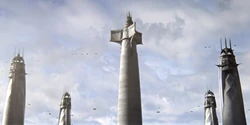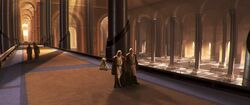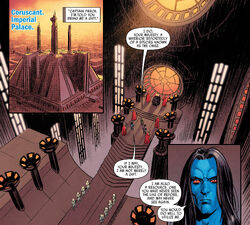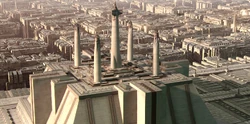| | |
Warning: This infobox has missing parameters: rebuilt, interest, type and unrecognized parameters: era
- "The Jedi Temple on Coruscant… It doesn't exist anymore. It's the Imperial Palace now."
- ―Kreel, to Luke Skywalker
The Imperial Palace, once known as the Jedi Temple when it was the home of the Jedi Order, was a complex on Coruscant that served as the seat of power for Darth Sidious during his reign as ruler of the Galactic Empire. As the headquarters of the Jedi, the Temple served the Order in three capacities: a monastery for the Jedi to reflect on the will of the Force; a training center for Jedi younglings and Padawans who endeavored to join the ranks of the Jedi Knights; and government, in which the Masters of the Jedi High Council guided the Order's direction.
After the fall of the Jedi Order and the Galactic Republic, the Temple became the Palace of the Emperor and a location for his dark side artifacts. It would serve as Sidious' residence for over two decades until his death at the Battle of Endor in 4 ABY. After the destruction of the Sith, Luke Skywalker—the last of the Jedi—recovered fragments of a Force-sensitive tree that was once located at the heart of the Jedi Temple.
Description
Jedi Temple
- "To get a holocron, I'd have to break into the Jedi Temple. It's impossible, not to mention deadly."
- ―Cad Bane, to Darth Sidious

Five distinctive spires crowned the top of the Jedi Temple ziggurat.
Set apart from the rest of the Federal District, the Jedi Temple was located in its own low-rise district known as the Temple Precinct. Dotted by statues and small parks, the Precinct was bisected by the Processional Way, a long road which terminated at a ceremonial staircase that led into the Temple's entrance hall. Crowned by four statues, two Warrior Masters and two Sage Masters, the main entrance was decorated with twelve massive pylons adorned with the depictions of the Temple's founding Four Masters.[1]
Constructed around and within a natural mountain spire, the Jedi Temple was an agglomeration of a series of shrines, temples, academies, and holy places which had dotted the site for millennia. A sacred place to numerous Force traditions, the Temple preserved some of these ancient structures for their architectural and historical merits, re-purposing them as museums or art galleries. The peak of the mountain spire at the facility's core was surrounded by ancient meditation balconies and access points to the mountain's interior, which was burrowed through with cave chapels and buried shrines. One of the earliest Jedi libraries at the site was eventually converted into a formal banquet hall. As the Jedi cemented their hold on the facility, they began to add their architectural flair to the building, forming a massive ziggurat around the mountain spire that completely encompassed it. The base of the ziggurat was a series of pillared halls that supported the weight of the structure above; additional rooms such as the Room of a Thousand Fountains and a rotunda chapel converted into a meditation hall made up the base of the ziggurat.[1] Higher in the main body of the Temple complex was a medical center staffed by the Medical Corps, a transformation chamber where a Jedi could be disguised as another individual,[6] containment cells for hostile Force-users, and a series of workshops, and maintenance facilities.[1] The Temple was also the home of the Jedi Archives, a wellspring of knowledge said to house the collective wisdom of the galaxy's scholars and historians.[5] Aside from its collections of holobooks and artifacts, the Archives housed the secured Holocron Vault, in which the Jedi stored their precious holocrons which was accessible only to Jedi Masters.[1]

The Temple's interior was vast and composed of many hallways.
The Temple's interior was cluttered with dormitories and classrooms to house and educate the youngest initiates and Padawans. Holographic training suites used sophisticated technology to create realistic combat scenarios for Jedi-in-training to use and better their skill with a lightsaber. A lightsaber crafting facility allowed Jedi to construct or upgrade their weapons between missions. More advanced classes were taught in facilities built after the Temple's initial construction and could be found throughout the Temple Precinct. The surface level of the ziggurat base was dotted with ancient temples and shrines from the Temple's earliest days. The Chamber of Conclave could be found among the shrines, where Jedi from across the galaxy gathered to hear an annual report from the High Council. Modern facilities were erected here too, such as the Temple's main vehicle garage and other facilities to house surface and ground vehicles. Throughout the Temple, visitors could find statues and tapestries that detailed the history of the Jedi Order. Stained-glass arcades and ancient tablets depicting battles and the Jedi Code preserved the Order's greatest heroes and most time-honored stories. The site which contained the most art and history was perhaps the central spire of the Temple. Erupting from the center of the ziggurat's flat roof, the central spire soared above the four peripheral towers which crowned the facility. Within its hollowed interior, the central spire contained massive memorial statues suspended on repulsorlift pads. At its peak, the central spire was adorned with three decorative fins, inside which was housed the Hall of Knighthood, wherein the status of Knight or Master was bestowed upon members of the Order. The pinnacle chamber of the central tower was home to the oldest known texts that the Order possessed. Members of the Jedi High Council would occasionally meet within this chamber to discuss the future of the Order.[1]

The Temple's graceful corridors were places for Jedi to congregate with colleagues or reflect on the will of the Force.
The roof of the Temple's ziggurat was accessible to Jedi and was often used for outdoor sparring sessions by younglings and Padawans alike.[7] A gnarled, ancient tree[8] stood in the shadow of the Temple's five crowning spires, and was a place many Jedi came to find solace. Each of the four lesser towers of the Temple were crowned by an array of powerful reception and transmission antennas which tapped into hyperspace itself so that the Temple could be appraised of information in real-time. A pyramid system of holomaps worked furiously within the towers, starting with twelve teams at the base that monitored disturbances in the Force, before pushing potential threats all the way up to the large galaxy holomap situated below the pinnacle Council Chamber of each tower. Contemplation stations ringed the holomap level of each tower, allowing Jedi waiting to visit the Council to find peace before standing before the leaders of the Order. Within the Tower of Reassignment, the Chamber of Judgment was situated where Jedi could be judged when charged with violating one of the Order's strictures or galactic law. Each tower was equipped with a hangar and extendable landing platform where Jedi and visiting dignitaries alike could land and store their ships.[1] These tower hangars, equipped with a carbon-freezing facility where cargo could be frozen for transport, housed Delta-7 Aethersprite-class light interceptors, Low Altitude Assault Transport/infantry, and Eta-2 Actis-class light interceptors during the Clone Wars. Near the base of the High Council tower was the beacon through which the High Council could contact all Jedi across the galaxy.[1]
Imperial Palace

The Emperor's throne room
Five years after the end of the war and the fall of the Jedi Order, the Galactic Empire had refitted the ruined Jedi Temple into the Imperial Palace, which served as the residence of Darth Sidious, the Dark Lord of the Sith and Emperor of the galaxy. All that remained of the original temple was its quincunx of skyscraping spires, which crowned an amalgam of blockish edifices with sloping façades. The Temple Precinct, renamed as the Palace Precinct, housed a courtyard landing field that was large enough to accommodate Star Destroyers of the Victory and Venator classes. From that courtyard, the Palace's interior could be accessed through elaborate doors.[2] Along with the Naval Intelligence headquarters and the COMPNOR arcology, the Imperial Palace made up the supreme triangle of Imperial City's Federal District.[2] It was regarded as one of the grandest and most elegant structures on the entire planet.[9]
Inside the Palace, all remnants of the Order had been stripped away, with all of the ancient mosaics, tapestries, and paintings removed. The walls and plinths of the expansive corridors were left bare of statues and other art pieces,[2] though some banquet chambers were draped with Imperial flags and banners. One of the Temple's vast pillared halls had been converted into a ball room, with its walls ornately tiled and mirrored. Crystalline sculptures stood on pedestals and shifted shape from abstract forms into Imperial symbols during a ceremony to honor Imperial cadets.[9]
The central spire of the Imperial Palace housed the Emperor's throne room, from which he ruled the Empire. The Emperor's receiving room was a dimly lit chamber with huge windows that opened out onto the Coruscant skyline.[10] From within the pinnacle room of the central spire, the Emperor conducted his day-to-day business, descending down into the penultimate level,[2] or the former Hall of Knighthood[1], to his audience chamber.[2] While most of the Temple had been transformed to serve the Empire, the enormous holographic galactic maps located within the four peripheral towers were maintained so that the Emperor could behold problems within the Empire.[2]
History
Age of the Jedi
- "It was… It was so beautiful here."
- ―Jocasta Nu

Before the rise of the Empire, the Jedi Temple was the home of the Jedi Order.
The site of the Jedi Temple, and later the Imperial Palace, was considered a holy site on Coruscant for many millennia by dozens of Force-wielding traditions. Constructed around and within a natural mountain spire, these temples and shrines were rich in the Force, that permeated the site and imbued it with radiant energy. After falling under the control of the ancient Sith, the Jedi Order's enemies erected a shrine on the mountain from which they dominated Coruscant. When the Jedi reclaimed the mountain during the Sith war in which the site switched hands, the Jedi reduced the Sith facility to its foundations and stripped away all remnants of their fallen foe. Unbeknownst to the Jedi, a hidden portion of the shrine endured in the foundations of the mountain, forgotten yet still active.[1] As the Order erected the Jedi Temple over the mountain, the shrine's malevolent energies continued to permeate the site, slowly clouding the Jedi's collective use of the Force with the power of the dark side.[2]
At one time, the Temple housed an artifact known as the darksaber—a black-colored lightsaber constructed by Tarre Vizsla, the first Mandalorian inducted into the Jedi ranks.[11] The darksaber would remain in the Order's possession until the fall of the Old Republic,[4] at which point members of House Vizsla[11] stole the weapon while sacking the Temple.[4]
During the era known as the Dark age, during the Jedi–Sith war, the Sith attacked Coruscant and took possession of both the planet and the temple. Later in the war, in 1032 BBY, the Jedi repelled the invaders during the Liberation of Coruscant.[12]
In the ensuing millennium, an era dominated by the Galactic Republic, the Jedi Temple was rebuilt and expanded many times, formed from not a single structure, but many ancient temples and shrines woven together. For centuries the Temple would serve as the headquarters of the Jedi Order, where the youngest initiates were trained in the ways of the Force and elevated to the rank of Jedi Knight. Learning how to use the Force, the martial arts, diplomacy, and meditation, the Jedi thrived within their home as the Galactic Republic grew more and more corrupt. The governing body of the Order, the Jedi High Council, sat in the High Council Tower, one of the four peripheral towers around the Temple Spire, in addition to the Council of First Knowledge, the Council of Reconciliation, and the Council of Reassignment. After a thousand years of consecutive peace and prosperity, the Jedi Order was plunged into conflict with the Sith once more during the Clone Wars.[1] As the Jedi had taken leadership over the Grand Army of the Republic, many military affairs were conducted from within the Jedi Temple, as classrooms were converted into military briefing rooms.[1] As public sentiment began growing against the war, protests were staged on the front steps of the Temple, while one of its hangars was bombed by Padawan Barriss Offee, who believed the Jedi only cared about violence.[13]
Age of the Empire
The Emperor's death was celebrated in Monument Plaza, near the Imperial Palace.
At the end of the Clone Wars, Darth Sidious—publicly known as Supreme Chancellor Sheev Palpatine—declared that the Jedi, who had attempted to arrest him after discovering he was the Dark Lord of the Sith, were traitors. He issued Order 66, a command to all clone troopers to kill the Jedi. Meanwhile, Jedi Knight Anakin Skywalker fell to the dark side and became the Sith Lord Darth Vader, and he led clone troopers to kill all of the Jedi within the Jedi Temple. This left the Jedi Temple damaged, and the Jedi Order destroyed.[1] Shortly thereafter, Sidious declared that the Republic was to be transformed into the Galactic Empire, with himself as Emperor. In the aftermath of the Temple's desecration, lightsabers belonging to dead Jedi were incinerated on the steps of the old Temple in a massive celebration.[14] Not five years after the destruction of the Jedi Order, the Jedi Temple was converted into the Imperial Palace. Transferring his collection of dark side artifacts stored within the Grand Republic Medical Facility to their new home in the Imperial Palace, the Emperor made it his primary residence, leaving the day-to-day governance of the Empire to his advisers.[2]
While the former Jedi Kanan Jarrus ruminated on the notion that nothing of the Temple remained,[15] the Imperial Palace endured until after the death of Darth Sidious during the Battle of Endor.[16]
Behind the scenes
The Jedi Temple was first introduced in the 1999 film Star Wars: Episode I The Phantom Menace, and became a major location in The Phantom Menace and its two sequels,[17] Star Wars: Episode II Attack of the Clones[18] and Star Wars: Episode III Revenge of the Sith.[19] In 2004, the Jedi Temple was added into the ending of Star Wars: Episode VI Return of the Jedi, during the final montage of planets celebrating the death of the Emperor.[16] The novel Tarkin by James Luceno, released in 2014, revealed that the Jedi Temple was converted into the Imperial Palace.[2] However, The Rebellion Begins by Michael Kogge, which serves as an adaptation of Star Wars Rebels: Spark of Rebellion, shows Kanan Jarrus remembering the destruction of the Jedi Temple.[15] Whether he was referring to the Temple's refit into the Imperial Palace or if this is a continuity error has not been resolved.
Appearances
Non-canon appearances
- Disney Infinity 3.0
 LEGO Star Wars: The Freemaker Adventures — "A Hero Discovered"
LEGO Star Wars: The Freemaker Adventures — "A Hero Discovered" LEGO Star Wars: The Freemaker Adventures — "Crossing Paths"
LEGO Star Wars: The Freemaker Adventures — "Crossing Paths" LEGO Star Wars: The Freemaker Adventures — "Return of the Kyber Saber"
LEGO Star Wars: The Freemaker Adventures — "Return of the Kyber Saber" LEGO Star Wars: The Freemaker Adventures — "Trouble on Tibalt"
LEGO Star Wars: The Freemaker Adventures — "Trouble on Tibalt" LEGO Star Wars: The Freemaker Adventures — "The Tower of Aliston Nor"
LEGO Star Wars: The Freemaker Adventures — "The Tower of Aliston Nor" LEGO Star Wars: The Freemaker Adventures — "The Storms of Taul"
LEGO Star Wars: The Freemaker Adventures — "The Storms of Taul" LEGO Star Wars: The Freemaker Adventures — "The Pit and the Pinnacle"
LEGO Star Wars: The Freemaker Adventures — "The Pit and the Pinnacle" LEGO Star Wars: The Freemaker Adventures — "Flight of the Arrowhead"
LEGO Star Wars: The Freemaker Adventures — "Flight of the Arrowhead" LEGO Star Wars: The Freemaker Adventures — "A Perilous Rescue"
LEGO Star Wars: The Freemaker Adventures — "A Perilous Rescue" LEGO Star Wars: The Freemaker Adventures — "Escape from Coruscant"
LEGO Star Wars: The Freemaker Adventures — "Escape from Coruscant" LEGO Star Wars: Droid Tales — "Exit from Endor" (In flashback(s))
LEGO Star Wars: Droid Tales — "Exit from Endor" (In flashback(s)) LEGO Star Wars: Droid Tales — "Crisis on Coruscant" (In flashback(s))
LEGO Star Wars: Droid Tales — "Crisis on Coruscant" (In flashback(s))- Star Wars: Galaxy of Heroes
Sources
Notes and references
- ↑ 1.00 1.01 1.02 1.03 1.04 1.05 1.06 1.07 1.08 1.09 1.10 1.11 1.12 1.13 1.14 Star Wars: Complete Locations
- ↑ 2.00 2.01 2.02 2.03 2.04 2.05 2.06 2.07 2.08 2.09 2.10 2.11 Tarkin
- ↑
 Jedi Temple in the Databank (backup link)
Jedi Temple in the Databank (backup link)
- ↑ 4.0 4.1 4.2
 Star Wars: The Clone Wars — "The Mandalore Plot"
Star Wars: The Clone Wars — "The Mandalore Plot"
- ↑ 5.0 5.1
 Jedi Temple in the Encyclopedia (content now obsolete; backup link)
Jedi Temple in the Encyclopedia (content now obsolete; backup link)
- ↑
 Star Wars: The Clone Wars — "Crisis on Naboo"
Star Wars: The Clone Wars — "Crisis on Naboo"
- ↑
 "The Wrong Jedi" - The Clone Wars Episode Guide on StarWars.com (backup link (explore/the-clone-wars/ep520/#!/about) not verified!)
"The Wrong Jedi" - The Clone Wars Episode Guide on StarWars.com (backup link (explore/the-clone-wars/ep520/#!/about) not verified!)
- ↑ Shattered Empire, Part IV
- ↑ 9.0 9.1 Lost Stars
- ↑ Lords of the Sith
- ↑ 11.0 11.1
 Star Wars Rebels — "Trials of the Darksaber"
Star Wars Rebels — "Trials of the Darksaber"
- ↑ Star Wars Propaganda: A History of Persuasive Art in the Galaxy
- ↑
 Star Wars: The Clone Wars — "The Wrong Jedi"
Star Wars: The Clone Wars — "The Wrong Jedi"
- ↑ Darth Vader: Dark Lord of the Sith 1: The Chosen One, Part I
- ↑ 15.0 15.1 The Rebellion Begins
- ↑ 16.0 16.1 Star Wars: Episode VI Return of the Jedi
- ↑ Star Wars: Episode I The Phantom Menace
- ↑ Star Wars: Episode II Attack of the Clones
- ↑ Star Wars: Episode III Revenge of the Sith

